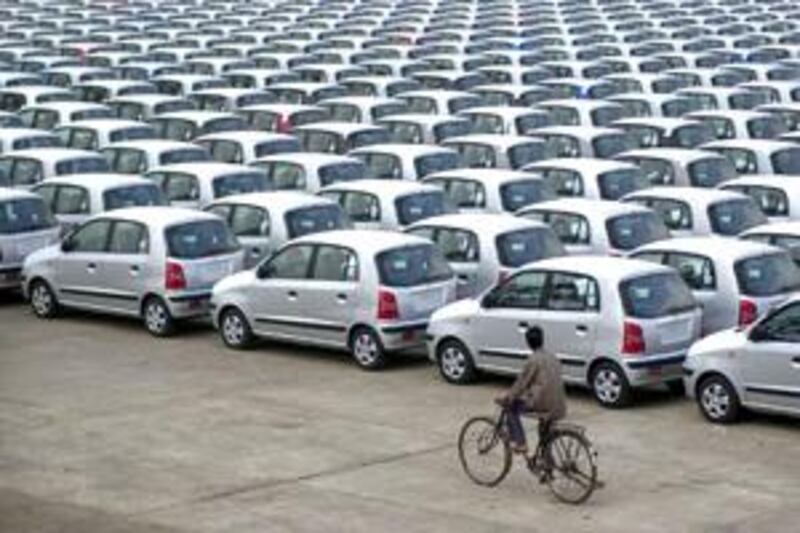If you take the short drive up from Uttam Galva's steel plant to the airy hill station of Lonavla and look down the other side towards Pune, the prospect before you is Chakan, "India's New Detroit". Volkswagen (VW) opened a state-of-the-art plant there in March; Mercedes-Benz opened an assembly plant in February; General Motors opened a year ago; Fiat began producing this month; Renault may soon shift here; and the Indian manufacturers Tata Motors, Mahindra and Bajaj are long-established.
Which is why the world's largest steel company, ArcelorMittal, launched a bid this month for a 29.4 per cent stake in Uttam Galva. The biggest steel supplier to the real Detroit is gearing up to supply its Indian successor. ArcelorMittal is not the only supplier targeting the area, according to David Hudson, an engineering manager at Tata Motors's plant nearby. "Almost every week there's news here of a major component supplier opening a technical centre or a manufacturing facility," he said.
"Some of the global suppliers who had previously been nervous about entering operations in India, they will now be hastening their investments because they have more and more customers building in India." Magna International, one of the world's largest car parts suppliers, announced last month that it was setting up a seating plant in Chakan. Lear and Bosch have already begun operations next door to VW, and next year VW plans to begin bringing more suppliers to the industrial park it is building alongside its plant.
"That will have a direct benefit for us," Mr Hudson said. "The economics will improve and also the technical support will be better." Materials suppliers such as Uttam Galva will improve their offerings, luring in higher quality car component suppliers, which will in turn bring in more higher-end car manufacturers, further encouraging companies such as ArcelorMittal to increase the quality of their materials.
At the start of this year, India's manufacturing revolution looked as if it had stalled. Industrial production across the country fell in December for the first time in 13 years, and then fell again in January. By February, Indian car sales had fallen year-on-year for six out of the previous eight months, ending a five-year run of growth. Renault and Nissan both scaled down their plans for India at the start of the year, slowing investment on their plant in Chennai and delaying the announcement of their intention to develop a low-cost car.
Between September and December last year, 70,000 to 80,000 workers were laid off by Indian car component manufacturers, according to the industry's trade body. The suffering was not just in car manufacturing. At the Nokia Telecom Park in Chennai, the Finnish mobile giant has struggled to build the consumer electronics cluster it planned in 2007. Jabil Circuit, one of the few suppliers Nokia had succeeded in attracting, shut down its US$100 million (Dh367m) plant at the start of the year.
But in the past few months, there has been an unexpectedly rapid revival. India's industrial sector grew 6.8 per cent year on year in July, the country's Central Statistical Organisation said last week, building on a 16-month high of 8.2 per cent year-on-year growth in June. This has almost entirely been driven by domestic demand. India's exports plunged by a third in March, the sharpest fall in 14 years, and are still expected to be down 19.7 per cent when last month's figures are released. The hope is that when international demand also begins to pick up, India's manufacturers will begin once again to boom.
Alan Rosling, the chairman of Griffin Growth Partners, India, who as a director of Tata Group drew up the globalisation plans that led to the acquisition of Jaguar Land Rover and Corus, said: "The change in mood is dramatic in the private sector in India, their tails are up in the air again." Mr Rosling, who advises corporations on their India strategies, said there were several manufacturing niches where India already had the edge on China. "China's an excellent place to do low-margin, high-volume assembly, and India's the best place to do customisable assembly."
Yezdi Nagporewalla, who heads the industrial practice at KPMG in India, agrees. "China has captured the low end of manufacturing, but as you move higher up the manufacturing chain, where you have aspects of precision, aspects of design, that's the space where India could compete, potentially." The British heavy machinery manufacturer JCB has just finished building the world's largest backhoe loader facility in India and is aiming for its revenues in India to pass $1 billion within three years.
Mahindra may for the first time this year overtake the US giant John Deere as the world's largest tractor manufacturer. India's car market, with 2.3 million units produced last year, is still dwarfed by China's production of 9.5 million. India may be starting to overtake China as a car exporter, however, it exported 230,000 cars in the first six months of this year, against China's exports of 165,000.
Next year, India's low-cost car speciality will become still more pronounced. The first Tata Nano may have hit India's streets in July, but it will only be when a new factory comes on line at the start of next year that it will begin to produce 250,000 a year. Hyundai already aims to export 300,000 of its I10 small car from India this year, and it will soon be joined by others. Ford will begin producing its own small car in India at the start of next year. Even Toyota, which is bleeding internationally, announced at the end of last month that it would invest to make India its small car centre for the world by 2012.
"It's an acceleration of the interest which was already building," Mr Hudson said. "India has weathered this downturn better than most countries. Both India as a market, and India as a manufacturing location have leapfrogged some of the second and third-tier countries in the boardrooms of the major auto manufacturers." @Email:business@thenational.aeIndian





